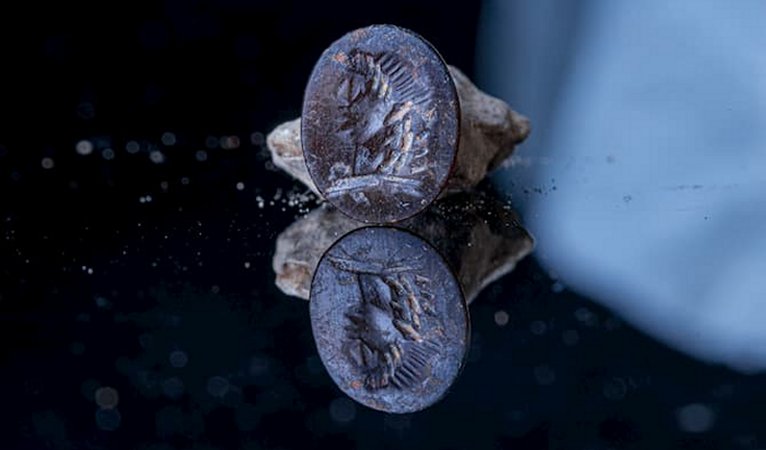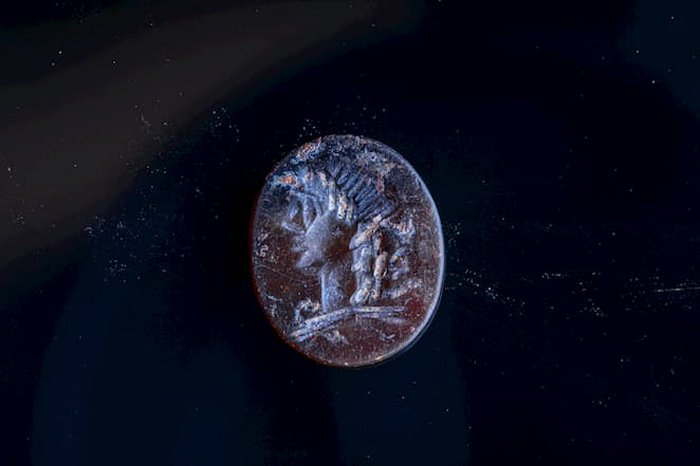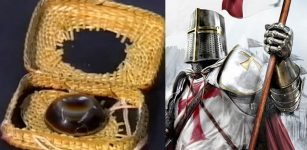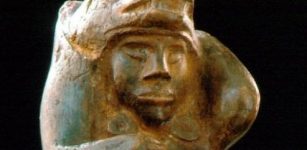How Did A Rare 2,000-Year-Old Gem Seal Depicting God Apollo End Up In The City Of David?
Jan Bartek – MessageToEagle.com – This beautiful 2,000-year-old gem seal was found in the drainage canal in the City of David in Israel. It’s a curious artifact because it depicts a portrait of Greek God Apollo, but scientists have reason to assume its owner was not Pagan. How did an ancient seal bearing the image of a foreign god end up in the City of David?

A gem seal depicting a portrait of Apollo. Credit: Eliyahu Yanai, City of David
The city of what is now called the City of David, was first established somewhere in the 3 millennium BC. It was Canaanite and though few archaeological discoveries have illuminated this history, it remained Canaanite until David conquered it in the 10th century BC.
The City of David remains controversial and archaeological excavations in this area can are often problematic.
So, it’s always nice to hear when something rare and of great value has been unearthed in this ancient historical city.
Ancient Seal Depicting A Portrait Of Greek God Apollo
This gem is cut from dark brown jasper, and has remnants of yellow-light, brown, and white layers. In antiquity, jasper was considered a precious stone. The gem seal was embedded in a ring, dated to the 1st century CE (Second Temple period).
The gem is tiny, oval-shaped, 13 mm long, 11 mm wide, and 3 mm thick. Because the gem is an intaglio, its main function was as a stamp to be used on soft material, usually beeswax, for personal signatures on contracts, letters, wills, goods or bundles of money. The gem features an engraving of Apollo’s head in profile to the left, with long hair flowing over a wide, pillar-like neck, a large nose, thick lips, and a small prominent chin.
The hair is styled in a series of parallel lines directed to the apex, and surrounded by a braid above the forehead. One line of hair marks a strand that covers the ear; long curls flow over part of the neck, reaching the left shoulder. Thin diagonal lines at the base of the head mark the upper end of the garment and the body.
Apollo was a powerful figure in Greek mythology. He was originally the god of shepherds and later after he was established at Delphi, he acquired power over medicine, healing, disease, archery, music, poetry and invented the arts.
Apollo was a loved and feared Greek God of divination and prophecy who was also seer of Zeus.
He was the one who had the ability to ward off all kinds of evils, but if necessary, he could send a plague and then avert it.
Researchers say that although Apollo is an Olympian deity of the Greek and Roman cultures, it is highly probable that the person wearing the ring was a Jew.
“When we found the gem, we asked ourselves ‘what is Apollo doing in Jerusalem? And why would a Jew wear a ring with the portrait of a foreign god?’ The answer to this, in our opinion, lies in the fact that the owner of the ring wore it not as a ritual act that expresses religious belief, but as a means of making use of the impact that Apollo’s figure represents: light, purity, health, and success,” Shukron added.

Credit: Eliyahu Yanai, City of David
“At the end of the Second Temple period, the sun god Apollo was one of the most popular and revered deities in Eastern Mediterranean regions. Apollo was a god of manifold functions, meanings, and epithets. Among Apollo’s spheres of responsibility, it is likely that association with sun and light, as well as with logic, reason, prophecy, and healing fascinated some Jews, given that the element of light versus darkness was prominently present in Jewish worldview in those days.
The fact that the craftsman of this gem left the yellow-golden and light brown layers on the god’s hair probably indicates a desire to emphasize the aspect of light in the god’s persona, as well as in the aura that surrounded his head.
See also: More Archaeology News
The choice of a dark stone with yellow coloring of hair suggests that the creator or owner of this intaglio sought to emphasize the dichotomous aspect of light and darkness and/or their connectedness,” Professor Shua Amorai-Stark, a researcher of engraved gems stated.
Written by Jan Bartek – MessageToEagle.com – AncientPages.com Staff Writer










